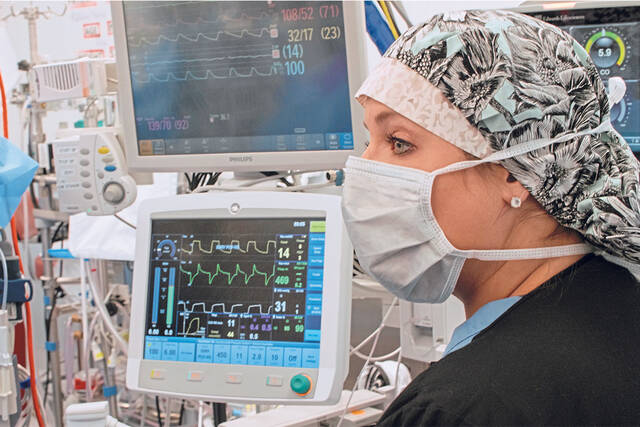Aortic Stenosis is the most common valvular abnormality among adults, with more than 200,000 cases per year across the United States. The prevalence increases with age, and most often it occurs in men over the age of 50.
The condition occurs when there is narrowing of the heart’s aortic valve. This narrowing keeps the valve from opening fully, reducing blood flow to the body and making the heart work harder over time.
What are the symptoms of aortic stenosis?
Dr. Baker: Current guidelines from the American Heart Association and the American College of Cardiology characterize symptoms of severe aortic stenosis as shortness of breath, angina, which is chest pain associated with reduced blood flow to the heart, syncope, or a temporary loss of consciousness due to a fall in blood pressure and palpitations. Often patients experience a decline in their exertional capacity. In other words, it takes longer to perform routine activities due to shortness of breath or fatigue.
How serious is the condition?
Dr. Baker: Severe aortic stenosis is clearly a life-threatening disease. Following the onset of the symptoms, mortality rates can approach 50 % after two years if the patient does not undergo valve replacement.
Can you explain the TAVR procedure?
Dr. Baker: Transcatheter Aortic Valve Replacement, or TAVR, provides significant benefits for the patient and has demonstrated outstanding results.
For decades, the previous standard of care for patients with severe aortic stenosis was traditional open-heart surgery. TAVR now offers an effective alternative method for many patients, especially for those who are at intermediate or high surgical risk due to advanced age or other underlying conditions.
The procedure does not require the heart to be stopped or the need for circulatory support during the procedure.
Utilizing a minimally invasive approach through the skin, the valve is typically implanted through a blood vessel in leg, the femoral artery, although other access points may be used. This approach eliminates the chest wall incision associated with conventional open-heart surgery. Days that the patient is hospitalized are reduced, as is post-operative pain medication.
Are there special technologies used in TAVR?
Dr. Baker: TAVR is the latest in a growing list of sophisticated procedures that are being performed in the newly opened Hybrid Operating Room at Westmoreland Hospital. This state-of-the-art surgical suite allows interventional cardiologists like myself and cardiac surgeons to work together in one room to perform traditional diagnostic functions of a cardiac catheterization lab, combined with the surgical capabilities found in a traditional operating room.
Most notably, its real-time intraoperative image guidance systems provide unparalleled imaging capabilities in the operating room itself-before, during and after the procedure. For patients, that can translate into a shorter procedure, less anesthesia, less post-operative recovery time and less risk for complication. All of these are especially beneficial considering the age of the majority of our TAVR patients.
How is a patient evaluated as a candidate for TAVR?
Dr. Baker: Prior to treatment, patients are evaluated within Excela’s Structural Heart Program by a multidisciplinary team that includes cardiothoracic surgeons, interventional cardiologists, cardiovascular imagers, cardiac anesthesiologists and nurse navigators. The team reviews cardiac imaging, coronary angiography and CT scans, along with a thorough clinical history in order to make the best clinical decision for each patient.
Optimal treatment is based on this team approach to assist patients in pursuing therapy that is most appropriate for their aortic stenosis.
Is TAVR now considered a mainstream therapy?
Dr. Baker: The use of TAVR in the treatment of aortic stenosis has certainly grown exponentially in recent years. In 2019, nearly 60,000 procedures were performed. It is estimated that by 2026, that number will increase to 130,000 a year nationwide. As device technology and the procedure itself continue to advance, so too will the number of eligible patients.
To what do you attribute that increase?
Dr. Baker: According to data from 2020, TAVR results show outstanding efficacy and efficiency related to postoperative deaths and complications. All-comer patients had an overall device success rate of over 95%, reflecting a low incidence of major complications, ill-fitting valves or the need for an additional procedure. The vast majority of patients- nearly 100 % - survived the procedure at 30-days, and 96% showed proper positioning of the valve with low rates of post-valve deployment regurgitation (or leakiness of the valve). Our experience at Excela mirrors these national results, and in certain areas, bests them This is especially compelling given that our patient age ranges from 65 to 97 years of age. That said, like any procedure there are risks, and they should be weighed against the risks of not addressing the stenosis via aortic valve replacement. In the final analysis, however, the mortality difference for patients with severe stenosis who undergo valve replacement versus those who don’t is one of the most striking in medicine.

